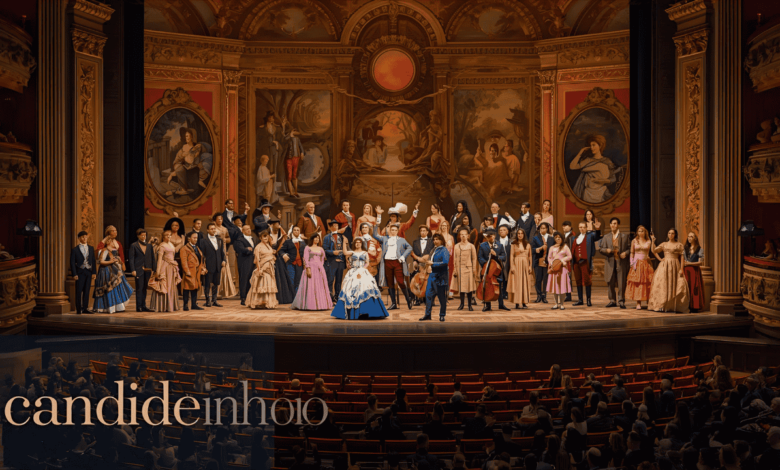Candideinohio: Exploring the Legacy and Impact of Bernstein’s Timeless Satire in the Heart of Ohio

The story of Candide has transcended centuries, languages, and continents, evolving from a philosophical novella into a dynamic operetta that continues to resonate with audiences worldwide. When it comes to its performances and cultural impact, candideinohio has become a fascinating topic, reflecting how timeless satire and music find fresh interpretations in modern American theater. From the stages of Ohio’s light opera houses to the academic productions at Ohio State University, the presence of candideinohio reveals how a classic story continues to inspire and challenge both artists and audiences.
Ohio has long been a hub of artistic expression, where theater and music intersect to bring thought-provoking stories to life. The ongoing appreciation and frequent productions of Bernstein’s adaptation of Voltaire’s Candide in the state offer a glimpse into the region’s thriving performing arts culture. Candideinohio captures that enduring relationship between philosophical storytelling and the musical brilliance of Leonard Bernstein.
The Origins of Candide and Its Journey to the Stage
Before exploring candideinohio, it is essential to understand where this story began. Candide was originally written by the French philosopher Voltaire in 1759 as a satirical novella. The book questioned the optimistic philosophy popularized by thinkers of his time, particularly the idea that “everything happens for the best.” The protagonist, Candide, embarks on a series of misadventures that expose the harsh realities of the world, challenging blind optimism and inviting readers to reflect on human nature.
In 1956, Leonard Bernstein transformed Voltaire’s satirical tale into a musical operetta. With contributions from writers such as Lillian Hellman and Richard Wilbur, Bernstein’s Candide became a remarkable fusion of philosophical commentary and operatic humor. Over time, multiple revisions and adaptations followed, but the heart of the story remained intact—an exploration of optimism, suffering, and the search for meaning. Candideinohio brings this story to life through various performances that showcase the brilliance of both Voltaire’s wit and Bernstein’s music.
The Emergence of Candideinohio Productions
Candide has been performed across the world, but Ohio has played a particularly active role in reinterpreting and celebrating the operetta. The Ohio Light Opera, known for reviving classical works, staged a highly praised version of Candide, earning applause for its artistic creativity and musical depth. This production was notable for presenting the 1999 version adapted by John Caird, originally staged for the Royal National Theatre.
Another significant example of candideinohio comes from The Ohio State University’s Opera & Lyric Theatre program. Their production highlighted the flexibility of the operetta, as no single version is considered definitive. This allowed directors and students to explore various interpretations, combining traditional satire with modern relevance. The performances at Ohio State demonstrated how candideinohio bridges academic learning with professional artistry, giving new performers a chance to experience the complexity of Bernstein’s score and Voltaire’s humor.
Additionally, the Cincinnati Symphony Orchestra and May Festival have presented concert versions of Candide, showcasing Bernstein’s musical genius through powerful orchestral arrangements. These performances not only attracted seasoned opera enthusiasts but also introduced new audiences to this masterful blend of classical and contemporary art.
The Themes That Keep Candide Relevant in Ohio
One reason candideinohio continues to attract attention is its timeless message. The operetta, much like Voltaire’s novella, addresses the human condition, faith in optimism, and the harsh realities of existence. These themes continue to resonate with modern audiences, especially in times of uncertainty and social change.
Ohio’s performing arts community finds in Candide a perfect reflection of both the humor and tragedy of life. Productions of candideinohio often emphasize how the characters’ experiences mirror the struggles and hopes of everyday people. This connection between story and society ensures that every performance feels contemporary, even though the story itself dates back to the 18th century.
The Musical Brilliance of Bernstein’s Candide
The musical side of candideinohio is as remarkable as its philosophical core. Leonard Bernstein’s score is widely celebrated for blending classical composition with Broadway-style flair. The overture alone is one of the most frequently performed pieces by orchestras worldwide, admired for its energy, precision, and joyful spirit.
In Ohio productions, the orchestral and vocal demands of Candide have been both a challenge and a delight for musicians. The intricate melodies, quick tempo changes, and lyrical humor test the abilities of performers, while the audience enjoys a vibrant and intellectually engaging musical experience. The rich orchestration found in candideinohio performances proves how music can elevate storytelling, turning satire into a living, emotional experience.
Challenges of Staging Candide in Ohio
Staging candideinohio is no easy task. Directors often face the difficulty of choosing among the many available editions of the operetta. Each version presents differences in dialogue, scene structure, and musical arrangement. The production also requires a large and versatile cast capable of switching between comedic, dramatic, and musical performances seamlessly.
Ohio’s theater groups, such as the Ohio Light Opera, have shown exceptional skill in handling these challenges. Their attention to detail, costume design, and stage direction allow audiences to experience Candide as both a grand spectacle and a deeply reflective story. The scale of candideinohio productions demonstrates the dedication of Ohio’s artistic community to preserve and innovate classical works for modern audiences.
The Cultural Impact of Candideinohio
Beyond its artistic success, candideinohio has a cultural impact that extends into education, community engagement, and appreciation for literary history. By performing Candide in Ohio, local artists and institutions are not only celebrating Bernstein and Voltaire but also fostering a dialogue between classical philosophy and contemporary life.
Audiences leave these performances inspired by the question at the heart of Candide: can optimism survive in a world full of hardship? The answer may differ for everyone, but the discussion itself strengthens the value of theater and art in society. Through candideinohio, Ohio continues to nurture a culture that values both entertainment and intellectual reflection.
Conclusion
Candideinohio represents more than a series of performances; it is a testament to the enduring power of art, philosophy, and music. From Voltaire’s witty critique of optimism to Bernstein’s brilliant adaptation, this story has found new life in Ohio’s theaters, universities, and orchestras. Each performance brings fresh meaning to the age-old question of how we confront life’s absurdities while holding on to hope. As long as artists and audiences in Ohio continue to engage with this timeless work, candideinohio will remain a symbol of creativity, resilience, and the human desire to find meaning in every possible world.
Frequently Asked Questions
1. What does candideinohio refer to?
Candideinohio refers to the various performances and interpretations of Voltaire’s Candide and Bernstein’s operetta adaptation staged within Ohio’s theaters, universities, and orchestras.
2. Why is Candide popular in Ohio’s performing arts community?
Candide is popular because it combines humor, philosophy, and powerful music, giving Ohio’s artists a chance to explore complex themes while entertaining audiences.
3. Which theaters have staged candideinohio?
Major contributors include the Ohio Light Opera, The Ohio State University Opera & Lyric Theatre, and the Cincinnati Symphony Orchestra through the May Festival.
4. What makes candideinohio productions unique?
Each production offers a distinct interpretation of Bernstein’s music and Voltaire’s satire, often blending traditional and modern elements to appeal to today’s audiences.
5. What is the central message of Candide as reflected in candideinohio?
The central message remains the critique of blind optimism and the belief that through experience and resilience, people can find meaning even in an imperfect world.


